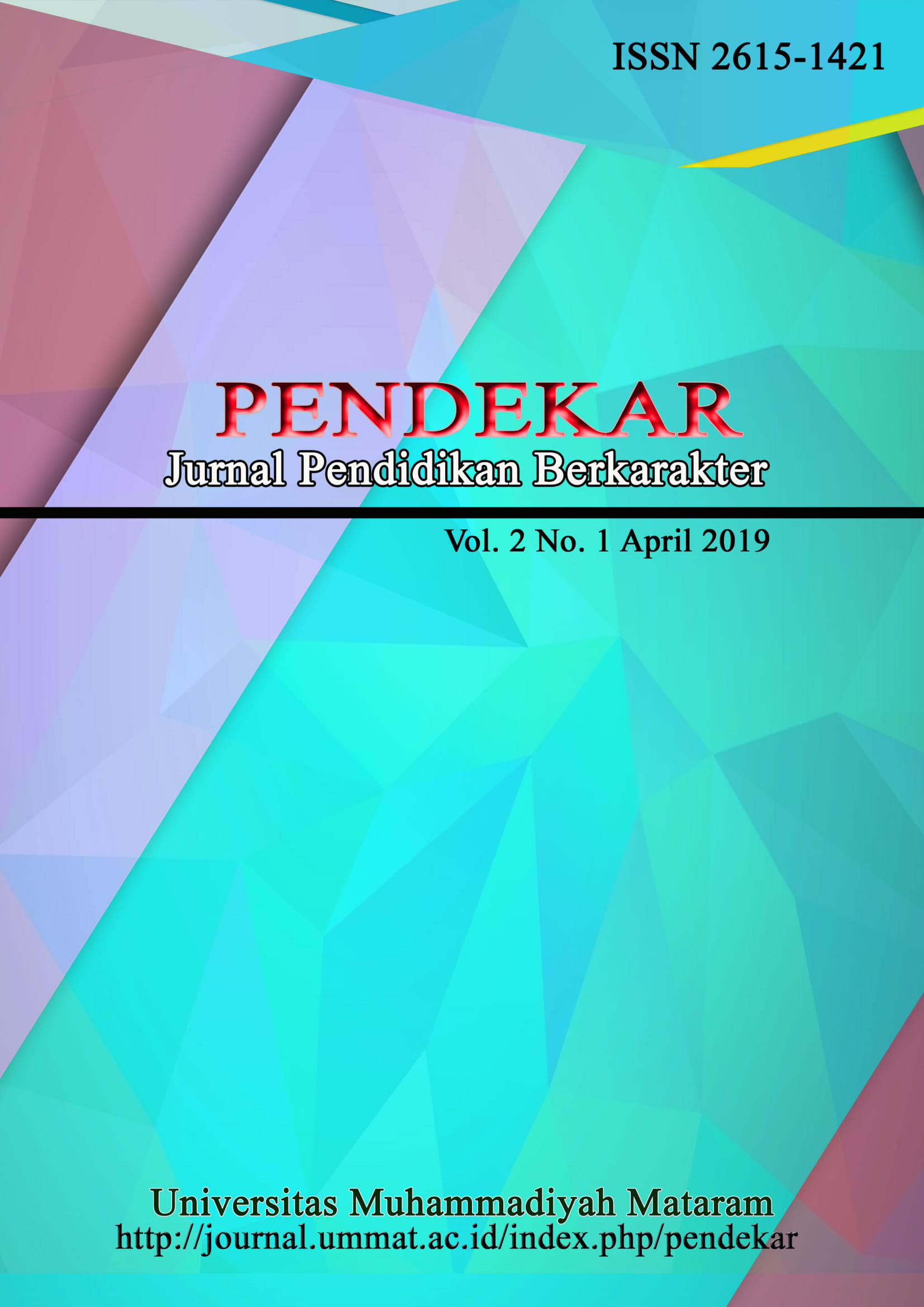KARAKTER DAN SIFAT KEJUJURAN MAHASISWA MELALUI KANTIN KEJUJURAN
DOI:
https://doi.org/10.31764/pendekar.v2i1.2905Keywords:
Karakter, Kejujuran, Mahasiswa.Abstract
Abstrak: Penempatan kantin kejujuran di lingkungan kampus merupakan salah satu fenomena unik dan sangat menarik untuk diteliti, karena sasaran dari kantin tersebut adalah peserta didik atau mahasiswa yang diharapkan dapat terbiasa untuk berperilaku jujur dimulai dari “kantin kejujuran†tanpa adanya penjual di kantin tersebut. Penelitian ini bertujuan untuk menganalisis karakter dan sifat jujur mahasiswa fakultas “F†di kampus “Fâ€. Penelitian ini menggunakan pendekatan kualitatif dan sumber data yang diperoleh yaitu berupa kata-kata, tindakan dan data tambahan seperti dokumen, hasil wawancara dan hasil observasi. Hasil penelitian menunjukan bahwa karakter dan sifat jujur mahasiswa fakultas “F†di kampus “F†kurang jujur, ditunjukkan dari jumlah uang tidak sesuai dengan harga bahan makanan yang ditinggal dengan penanda harga setiap bahan makanan sebagai objek atau alat penelitian. Kendala dalam pelaksanaan kantin kejujuran di fakultas “F†jaman sekarang yaitu minat mahasiswa terlalu sedikit terhadap kantin kejujuran sehingga mempersulit tim dalam menganalisis karakter jujurnya. Sehingga perlu dilakukan sosialisasi penyelengaraan, dan harus memaparkan hal-hal menarik yang ada di dalam kantin kejujuran yang diselengarakannya.
Abstract: The placement of honesty canteen in the campus environment is one of the unique phenomena and very interesting to research because the target of the canteen is students or students who are expected to be accustomed to behaving honestly starting from the "honesty canteen" in the absence of a seller in the cafeteria. This research aims to analyze the character and honest nature of faculty-student "F" on campus "F". This research uses a qualitative approach and the source of data obtained is in the form of additional words, actions, and data such as documents, interview results, and observation results. The results showed that the character and honest nature of faculty-student "F" on campus "F" was less honest, indicated by the amount of money that does not match the price of groceries left with the price marker of each footage as an object or research tool. The obstacle in the implementation of honesty canteen in the faculty "F" today is that the interest of students is too little towards the honesty canteen to make it difficult for the team to analyze its honest character. So it is necessary to socialize the maintenance and must explain the interesting things that are in the honesty canteen that it is involved in.References
Anam, K., & Sakiyati, I. D. (2019). Kantin Kejujuran Sebagai Upaya Dalam Pembentukan Karakter. Al Qalam: Jurnal Ilmiah Keagamaan Dan Kemasyarakatan, 21–32.
Arrahim, A. (2016). PENGEMBANGAN PENDIDIKAN KARAKTER MELALUI KANTIN KEJUJURAN. Jurnal Civic Hukum, 1(2), 49–55.
Bolotio, R., Ilham, A., & Mihratti, O. I. (2020). Implementasi Kantin Kejujuran Dalam Melatih Karakter Jujur Peserta Didik di SMA Negeri 6 Manado. Journal of Islamic Education: The Teacher of Civilization, 1.
Creswell, J. W. (2014). Penelitian Kualitatif dan Desain Riset, diterjemahkan oleh Ahmad Lintang Lazuardi. Yogyakarta: Pustaka Pelajar.
Creswell, J. W., & Creswell, J. D. (2017). Research Design: Qualitative, Quantitative, and Mixed Methods Approaches. Sage publications.
Eliasa, E. I. (2013). Peran Bimbingan dan Konseling dalam Pendidikan Karakter Siswa. UNY.(http://himcyoo. files. wordpress. com/2012/04/. pdf) diakses tanggal.
Indonesia, R. (2003). Undang-undang Republik Indonesia Nomor 20 tahun 2003 tentang Sistem Pendidikan Nasional. Jakarta: Pemerintah Republik Indonesia.
Martanti, F. (2017). Penanaman Nilai-Nilai Kejujuran melalui Media Kantin Kejujuran di Pondok Pesantren Al Hikmah Semarang. Sosio Dialektika, 2(1).
Moleong, L. J. (2016). Metodologi Penelitian Kualitatif. Bandung: Rosda.
Nurrokhmansyah, L. F. (2011). Upaya Mewujudkan Nilai-Nilai Kejujuran Siswa melalui “Kantin Kejujuran†di SMP Negeri 7 Semarang. Universitas Negeri Semarang.
Saddam, S., Setyowati, D. L., & Juhadi, J. (2016). Integrasi Nilai-nilai Konservasi dalam Habituasi Kampus untuk Pembentukan Kepribadian Mahasiswa Universitas Negeri Semarang. Journal of Educational Social Studies, 5(2), 128–135.
Saddam, S., Zurohman, A., & Bahrudin, B. (2018). The Integration Strategy of Conservation Values in Habituation of Semarang State University Campus. IJECA (International Journal of Education and Curriculum Application), 1(2), 1–13.
Salirawati, D. (n.d.). PARTICIPATION OF CAMPUS COMMUNITY IN CREATING CHARACTERIZED CAMPUS CULTURE.
Sawaludin, S., Muttaqin, Z., Sina, S., & Saddam, S. (2019). Penerapan Model Pembelajaran Kreatif Produktif Untuk Meningkatkan Aktifitas Belajar Mahasiswa Melalui Lesson Study Di Program Studi Pendidikan Pancasila Dan Kewarganegaraan. INOPENDAS: Jurnal Ilmiah Kependidikan, 2(1).
Sugiyono. (2013). Metode Penelitian Pendidikan Pendekatan Kuantitatif, Kualitatif, dan R dan D. Bandung: Alfabeta.
Sugiyono. (2017). Metode Penelitian kuantitatif kualitatif dan R dan D. Alfabeta: Bandung.
Sugiyono, H. (2016). Metode kualitatif dan kuantitatif. Cetakan Ke-23. Alfabeta, Bandung.
Downloads
Published
Issue
Section
License
Authors who publish articles in International Journal on Student Research in Education, Science, and Technology agree to the following terms:
- Authors retain copyright of the article and grant the journal right of first publication with the work simultaneously licensed under a CC-BY-SA or The Creative Commons Attribution–ShareAlike License.
- Authors are able to enter into separate, additional contractual arrangements for the non-exclusive distribution of the journal's published version of the work (e.g., post it to an institutional repository or publish it in a book), with an acknowledgment of its initial publication in this journal.
- Authors are permitted and encouraged to post their work online (e.g., in institutional repositories or on their website) prior to and during the submission process, as it can lead to productive exchanges, as well as earlier and greater citation of published work (See The Effect of Open Access).

